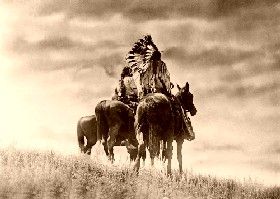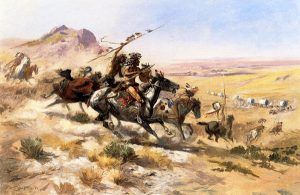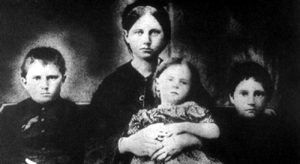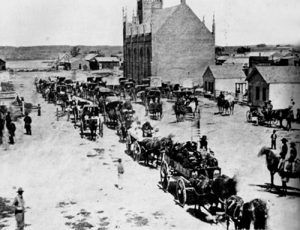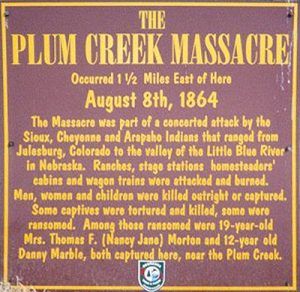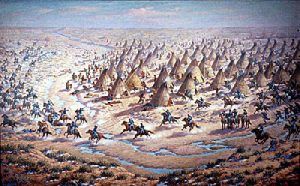In the early 1860s, the Cheyenne and Arapaho tribes were suffering terrible conditions on their reservation and, in 1864, began to retaliate by attacking stagecoaches and settlements along the Oregon Trail. Sometimes aided by the powerful Sioux, the most severe attacks were along the upper Little Blue River in Nebraska, where about 100 people were killed. Several died at Oak Grove, but others escaped, and Pawnee Ranch was successfully defended. At “The Narrows,” the Eubanks families were attacked, and seven were killed. Mrs. Eubanks, two children, and Miss Laura Roper were taken prisoner and held captive for months. Teamsters were killed, wagon trains burned, and ranches were smashed or burned. The settlers fled east to Beatrice and Marysville or northwest to Fort Kearny on the Platte River for protection.
The warriors were eventually subdued following the Sand Creek Massacre of November 29, 1864, when a 700-man force of Colorado Territory Militia attacked and destroyed a friendly Cheyenne and Arapaho village encamped in southeastern Colorado Territory.
The massacre resulted in the killing and mutilation of an estimated 70-163 Indians, about two-thirds of whom were women and children. They eventually accepted a reservation in the Indian Territory, but not before a large band was caught bypassing the reservation by Colonel George A. Custer in 1866 and subdued near the Washita River in Oklahoma.
Battles:
June/July 1864 – On June 3, 1864, the post office agent at Fort Leavenworth, Kansas, complained to General Samuel Curtis of westbound mail train robberies by the Cheyenne. On the same date, Colorado Governor John Evans sent a second request for troops to General Curtis, stating: “It will be destruction and death to Colorado if our lines of communication are cut off, or if they are not kept so securely guarded as that freighters will not be afraid to cross the plains, especially by the Platte River, by which our subsistence comes.”
In the meantime, Cheyenne Dog Soldiers and Sioux warriors consolidated and, on July 17, began running raids along the Republican and Platte River routes. Eight vicious attacks left a half-dozen white settlers dead, and several hundred heads of horses and cattle were stolen. The Platte Route, Denver’s primary source of supplies, was cut off as the warriors moved toward unprotected Denver. Though Governor Evans continued to plead to Washington, D.C., for help, the Civil War in the east preoccupied General Curtis and the War Department.
Little Blue River Raid (August 7-9, 1864) – Settlements along Little Blue River in Nebraska and Kansas were attacked by Cheyenne Dog Soldiers, Arapaho, and Sioux warriors. The Indians rampaged along the Overland Trail. Particularly hard-hit were ranches along a 60-mile stretch of the Little Blue River between present-day Fairbury and Hastings, Nebraska. When the raids were over, Indians had killed 38 settlers, wounded nine, and captured five. Today, roadside historical signs tell of the events in the vicinity, but exact locations are mostly unmarked and inaccessible on private farmlands.
Eubank Homestead (August 7, 1864) – Located 1.5 miles northwest of Oak, Nebraska, Indian warriors destroyed the Eubank homestead and killed two children who were home alone. A short distance north of the ranch, three Eubank men and a teenage boy were slain while cutting hay, and a younger boy named Ambrose Asher, who was aged nine, was taken captive. Another 1/2 miles to the northwest, the Eubank parent, their two babies, and a visiting 16-year-old girl were strolling along the Narrows section of the trail when they heard screaming from the homestead behind them. The father was slain as he ran to the aid of his children. The women and children hid in the brush but were discovered when the toddler screamed. All four — Lucinda Eubank, her children, Isabelle, age three, and Will, nine months; and 16-year-old Laura Roper were captured.
The warriors arrived at the Cheyenne and Arapaho encampment on the Smoky Hill River with their prisoners on August 12. Arapaho Peace Chief Left Hand made a trade with the warriors for Ambrose Asher, Laura Roper, and 3-year-old Isabel Eubank, whom the Indians had mistakenly identified as Laura’s child. Lucinda Eubank and baby Will were sold to a renegade Sioux warrior named Two Face, who immediately left the camp with his two white captives.
Ambrose, Laura, and Isabel, in the care of Left Hand, who was a decent and highly educated Arapaho leader, would farewell. Treated respectfully, Left Hand and Cheyenne Chief Black Kettle tried to negotiate their safe return in exchange for a truce with the soldiers. On September 11, 1864, they reached an agreement with Major Wynkoop, commander at Fort Lyon, Colorado, and were released. Laura Roper was reunited with her family. Three-year-old Isabelle Eubank was never reunited with her mother and was cared for by Dr. Brondsall of Denver. However, she never recovered from her ordeal and died shortly after that. Ambrose Asher was sent to live with his grandmother in Quincy, Illinois.
Mrs. Eubank, in the hands of a renegade clan, would be abused and assaulted for nearly a year.
Finally, almost demented, she and her son were brought into Fort Laramie, Wyoming, in May of 1865. On May 16, 1865, Sioux warriors Two Face and Blackfeet were hanged at the fort for the captives’ abuse. Lucinda Eubank recovered and learned that her daughter Isabelle had died. She and her son then made their way east, where she remarried in Missouri.
Plum Creek Massacre (August 8, 1864) – About two miles west of the Plum Creek stage station, Mart Bowler’s corralled bull train was breaking camp on the south side of the Platte River when Cheyenne warriors attacked. Immediately hit by an arrow was a 14-year-old bullwhacker named William Gay, who fired a shot to alert the rest of the group. The teamsters immediately retaliated, firing their shotguns, and managed to drive them away. Two warriors were killed, and three of the teamsters were wounded.
The same day, two Denver-bound wagon trains were attacked about five miles to the east. The teams began to scatter as some 100 Cheyenne warriors swept down on the wagons from bluffs to the south. The first wagon train consisted of ten wagons with ten drivers and a cook, all belonging to E. F. Morton of Sidney, Iowa. All the men, including Mr. Morton, were killed, and Mrs. Morton was taken captive. The Indians drove away the 50 mules belonging to the train. The second wagon train included six wagons loaded with corn and machinery belonging to Michael Kelley of St. Joseph, Missouri. A boy named Dannie Marble was captured, and the rest of the men were killed.
In the meantime, Bowler’s bull train continued to the Plum Creek Station. Lieutenant Joseph Bone of the 7th Iowa Cavalry could not do more than telegraph a message to Fort Kearny. But it was too late. The Cheyenne disappeared with their two captives, leaving 13 emigrants dead in their wake.
Little Blue/Oak Grove Station (August 9-10, 1864) – On August 9, 1864, a suspiciously friendly party of some 20 Cheyenne Dog Soldiers and Sioux warriors dropped in for a visit at the Oak Grove Station. While visiting casually with nervous ranch workers, the warriors suddenly struck, killing two men and wounding two more. Eleven ranch workers fled into the ranch house, and another escaped into a grove of trees. The warriors then stole or destroyed about $50,000 in property and livestock. However, as an ox train approached, they abruptly drove off. The next day, after the survivors had fled, the warriors returned, setting fire to the original buildings. No original buildings remain today, but it is commemorated with a Pony Express monument.
Kiowa Ranch Station (August 10, 1864) – Between the old Kiowa Station and the Oak Grove Station are two sites where Indian attacks took place. About four miles west of the Kiowa Station, a marker designates the Emery Stagecoach Ambush site on the south side of the road. Here, a life-and-death race took place as a passenger-filled stagecoach was chased through the area by a war party. On the same day, about 1.5 miles to the southwest, is the old Bowie Ranch site. Here, a pioneer couple was slain in their home, and some $10,000 of property and livestock were stolen or destroyed.
These raids choked off the Platte and Republican Rivers, effectively isolating communications to Denver. Colorado Governor John Evans immediately sent a telegram to the Secretary of War, pleading for authorization to raise a militia under the army’s sanction. On August 11, a volunteer regiment was authorized, which guaranteed pay and supplies for 100 days.
The Cheyenne War of 1864 would culminate in the Sand Creek Massacre in Colorado on November 29, 1864
©Kathy Alexander/Legends of America, updated April 2024.
Also See:
Indian Wars, Battles & Massacres
Indian Wars of the Frontier West by Emerson Hough
Winning The West: The Army In The Indian Wars

